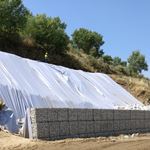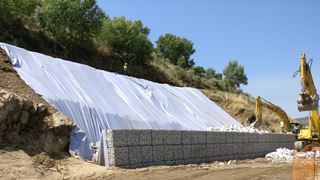Case story
Widening of the A15
The Netherlands, Zuid-Holland, Maasvlakte, Rotterdam
Challenge
Commissioned by the Department of Waterways and Public Works, the A15 between the Maasvlakte and the Vaanplein interchange is widened. This part of the A15 is the most important road between the port of Rotterdam and the rest of the Netherlands and Europe.The aim is to reduce the number of traffic jams and ensure that the surrounding area is safer and remains accessible. The road is therefore being widened from 2 x 3 to 2 x 5 traffic lanes, which translates into an additional 85 kilometres in total. One problem is that the A15 runs through a region with poor soil conditions. Construction work on a weak subgrade runs the risk of unwanted settlements, leading to a damaged road surface. Widening part of the A15 demands reinforcement of the weak subgrade.
Solution
Piled embankments with geosynthetics from TenCate are eminently suitable for this purpose and furthermore they help to reduce project duration and costs. Considerable time is usually involved in soil stabilization, but by installing a pile-supported foundation under the base course, in combination with a reinforced layer of geotextile, an embankment can be built in a short space of time and settlements are prevented. Piled embankments are therefore used to create a firm base. A piled embankment consists of a foundation of piles with a reinforced base course on top. The bottom part of the base course, which is called the ‘mattress’, is composed mainly of granulates that is reinforced with one or more layers of geosynthetics: a geogrid such as TenCate Miragrid® GX or geotextile such as TenCate Geolon® PET.The geosynthetic reinforcement lies at the bottom of the mattress. The most important function of a reinforced mattress is transferring the major part of the vertical load from the structure to the piles and absorbing the horizontal spreading forces in the base course.
Benefit
By applying piled embankments with geosynthetics, construction time is reduced, leading to less traffic disruption. Fewer piles are needed and the road builder can use less building materials. The life span of such a structure is minimum one hundred years, and the road surface requires considerably less maintenance. The A15 MaVa project is being carried out in five stages and is expected to be completed by the end of 2015.








